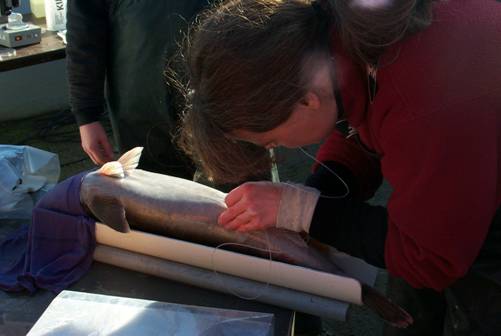
First 6-Month Report
USING SABLEFISH TO CREATE A TECHNICAL BASE FOR MARINE FISH AQUACULTURE IN THE PACIFIC NORTHWEST
Period Covered: September 1, 2001 – March 1, 2002
PI: R.N. Iwamoto and Co-PI: M.B.
Rust
Resource Enhancement and
Utilization Technologies Division
Northwest Fisheries Science Center
2725 Montlake Blvd. E
Seattle, WA 98112
The long-term objective of this
project is to develop a viable aquaculture system for the production of sablefish.
The specific technical objectives of this project are: 1) develop a pilot-scale,
recirculation, photoperiod-controlled juvenile production system; 2) develop
cost-effective feed formulations and identify sustainable feed ingredients appropriate
for sablefish; 3) monitor environmental effects and develop grow-out methods
for traditional net-pens, off-shore cages (suitable for aquaculture in the EEZ),
and land-based systems on a pilot scale; 4) investigate dietary effects on product
quality, and 5) insure quick technology transfer and demonstration to user groups.
To meet these objectives the following tasks were outlined Task 1. Seed Production,
Task 2. Nutrition, Task 3. Pilot Scale Grow-out Technology, Task 4. Product
Quality, and Task 5. Demonstration and outreach. This report will highlight
progress made in each of these tasks. Sub task titles within each group are reported
along with the key researcher responsible for completing each sub-task. In
most cases there is a one-to-one relationship between sub-tasks and planned publications.
THE EFFECT OF PHOTOPERIOD MANIPULATION ON THE SPAWNING TIMING OF WILD CAUGHT ADULT SABLEFISH. Briony Campbell and Eric Kroeger
Three months prior to the start
of this project, three populations of sablefish (approximately 90 animals total)
were switched to photoperiod regimes designed to advance by2 months, delay by 2 months or mimic natural spawning times.
At the time of this report we are in the middle of the first natural spawning
period. Approximately 10% of the fish in the advance group spawned prior to
the beginning of the natural spawning season and none spawned during the natural
season. A similar number of fish from the natural spawning period spawned during
the natural spawning period, and based on bioassay of oocytes Fig.1 and 2),
a similar or greater number in the delayed group areexpected
to spawn after the natural spawning season.
Spawning induction has been made successful by use of slow release hormonal
implants made in our lab. Our results indicate that it is possible to use
intensive state-of-the-art recirculation systems and photoperiod control to
produce year-round
spawning in this species. We werealso able to rear the resulting eggs to hatch.
Further progress with the eggs and larvae is pending NMFS FY03 funding to up-grade
our hatchery facility.

Figure 1. Biopsy of ovary to determine the state of oocyte development and predict spawning
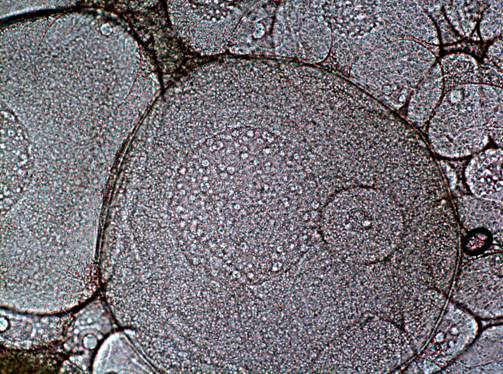
Figure 2. Photomicrograph of oocytes removed during biopsy.
MATURATION OF CAPTIVELY REARED JUVENILE SABLEFISH. Briony Campbell and Ken Massee
Two year old sablefish have been sampled (for reproductive endocrine hormones and histology) quarterly for the past two quarters to determine the onset of puberty in captively reared sablefish. Results of this study will require an additional 1-2 years or until the fish become reproductive.
THE EFFECT OF DIETARY FAT LEVEL ON GONADAL DEVELOPMENT IN THREE-YEAR-OLD CAPTIVELY REARED SABLEFISH. Briony Campbell and Ken Massee
Sablefish juveniles (Figure 3) are being feed diets containing differing levels of fat (10-30% of diet) to determine the optimal dietary fat level for reproductive performance. This study will conclude a year and a half from the time of this report.
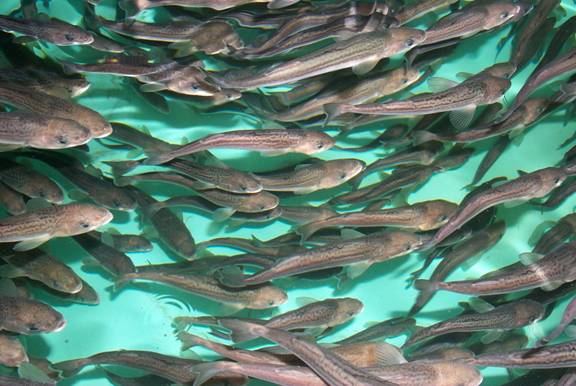
Figure 3. Sablefish juveniles prior to stocking for a feeding trial.
THE EFFECTS OF DIETARY PROTEIN AND FAT CONCENTRATION ON FEED INTAKE, FEED EFFICIENCY, GROWTH AND BODY COMPOSITION OF JUVENILE SABLEFISH. Karl Shearer
The purpose of the experiment was to examine the relationships between dietary protein and fat level; and feed intake, feed efficiency, growth and body composition in sablefish. Based on preliminary analysis the optimum protein/fat ratio in the diet to produce maximum weight gain appears to be approximately 38% protein to 25% fat (Figure 4). The remaining data collected from this experiment will be subjected to response surface analysis to determine the effects of the diets on the other parameters.
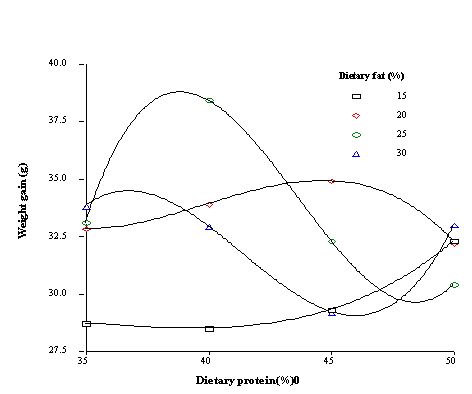
Figure 4. Weight gain of juvenile sablefish feed diets differing in protein and fat level.
REPLACEMENT OF FISH MEAL BY SOY PROTEIN CONCENTRATE IN DIETS FOR JUVENILE SABLEFISH. Mark Tagal
A feeding study was conducted to
evaluate soy protein concentrate as an alternative protein source for juvenile
sablefish. It was determined that 25-50 % of the fish meal in sablefish diets
could be replaced with soy protein concentrate with no decrease
in growth.(Fig.
5). The primary reason for the lower growth at higher levels of inclusion wasdue
to palatability problems with the soy protein concentrate as fish on the diets
with high inclusion rates ate less diet.
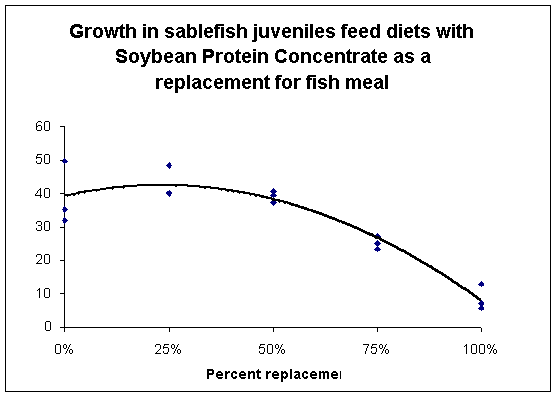
Figure 5. Weight gain in juvenile sablefish fed diets for 5 weeks with increasing levels of soy protein concentrate as a replacement for fish meal as the protein source.
COMPARATIVE DIGESTIVE EFFICIENCY OF DIETS FEED TO ATLANTIC SALMON AND SABLEFISH.
Kate Guthrie
Several test diets were fed
to both Atlantic salmon and sablefish to compare digestive efficiency between
the two species. Sablefish were significantly more efficient at using dietary
protein than Atlantic salmon (Table 1). This research formed part of Kate Guthrie’s
MS thesis at the University of Washington (spervised by Faye Dong, Dr. Dong
and the Co-PI). It also won the best student paper award at the 2002 Aquaculture
America meeting.
GROWTH OF JUVENILE SABLEFISH FEED DIETS CONTAINING A FISH PROCESSING WASTE HYDROLOSATE Harold Barnett and Pete Nicklason.
A feeding trial is underway that uses only fish processing waste by-products as a protein source for juvenile sablefish diets. The use of waste products for fish feeds can result in more full utilization of our living aquatic resources and can reduce pollution associated with fish processing facilities. Results will be available in 2-3 months.
ECONOMIC AND ENVIRONMENTAL CHARACTERIZATION
OF SABLEFISH AND COHO SALMON REARED IN SHORE-BASED TANKS, CONVENTIONAL NET-PENS
OR OFFSHORE CAGES. Ken Massee
A grow-out trial designed to determine
the economic viability and environmental effects of sablefish and coho
salmon grown using three technologies is scheduled to begin in July 2002. Unfortunately,
our corporate partner (Ocean Spar Technologies) who was to
provide the offshore cages (two 600 m3 SeaStations)
has been affected by the US recession and will no longer be able to
provide that equipment. The
cost for the project to purchase the required cages is approximately $70,000
which is beyond the budget of this project given the reduction from $499,000
to $450,000 at award and cuts to the program’s base funding. Therefore, we propose
to reduce the scope of this trial to include only tanks and conventional net-pens.
If sea-stations can be secured for next year the trial will be redesigned and
run at that time;otherwise the trial will be redesigned for the two technologies
(tanks and net-pens) to provide sufficient replication to complete the trial
in one year instead of the planned two years.
THE EFFECT OF DIETARY FAT LEVEL ON PRODUCT QUALITY IN THREE-YEAR-OLD CAPTIVELY REARED SABLEFISH. Faye Dong, Ken Massee, Sage Chaiyapechara and Harold Barnett
Sablefish juveniles are being fed
diets containing increasing levels of fat (10-30% of diet) until market size
(3 kg) to determine the optimal dietary fat level for the best product quality
in two key markets. This study will conclude in July 2002 and will provide
information needed to formulate a “finishing diet” for sablefish for each market.
An agreement has been reached with a Japanese fish import company to conduct
a blind quality evaluation of fish from the three treatments and wild caught
fish (by Makah tribal fishermen) in July 2002 Product quality will also include
a blind quality evaluation of smoked sablefish by a US company.
These
evaluations will supplement chemical, physical and taste panel evaluations done
in our lab. This work will be a portion of Sage Chaiyapechara’s Ph.D. dissertation
work (University of Washington) under the supervision of Faye Dong and the Co-PI.
This project has received a great deal of attention from industry and partners as highlighted below:
· One Makah tribal member has spent 6 months working side by side with NWFSC scientists learning the husbandry techniques that will be needed when the tribe begins production
· A Makah fisherman and a private company collectively purchased the fish (about $12K) to be used in the grow-out study. The Makah tribal government previously purchased fish for broodstock (about $2K) and the product quality trial. A private fishing company has already provided one ton of fish meal and will be donating several more tons of fish meal needed for the diets used in several studies.
· Six separate private groups or individuals have toured the facility and expressed their intent to develop sablefish aquaculture facilities when the technology is developed. These groups come from Washington, British Columbia, California and Hawaii. Additional interest from researchers in California and Oregon has been expressed.
· One technician from a cooperating private salmon hatchery has been working with NWFSC scientists to learn the broodstock care and spawning methods as they are worked out. A second private salmon hatchery has also expressed interest in setting up a sablefish hatchery.
· The Makah tribe obtained a grant and has commissioned a private aquaculture consulting company to develop a business plan for a tribal multi-species marine fish hatchery. The sablefish component of this hatchery would be to supply tribal member and non-tribal member owned sea cages.
·
The sablefish project will be highlighted as
part of the Northwest Fisheries Science Center’s 70th
anniversary
open house to be held at the NWFSC Manchester Research Station on May 24, 2002.
· Potential technology transfer through lectures and internships to students at the Northwest Indian College is being discussed. Additional discussions with the Peninsula College aquaculture program will conducted.
Back to National Strategic Initiative Project Summaries 2001